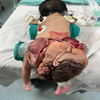Fetiform sacrococcygeal teratoma simulating parasitic twin: A case report
Keywords:
Sacrococcygeal teratoma, Fetiform teratoma, Parasitic twins, Neonate, Case reportAbstract
Background: Sacrococcygeal teratoma and parasitic twinning are distinct anomalies, each requiring different treatments and resulting in varied outcomes. Fetiform teratoma can mimic parasitic twins, posing diagnostic and management challenges.
Case Report: A one-hour-old neonate presented with active bleeding from a large, ruptured mass in the sacrococcygeal region. The mass contained identifiable organs, such as the scalp and an ear. Hemostasis was immediately secured with packing and dressing. MRI and tumor markers were performed to differentiate it from parasitic twins. The fetiform teratoma was excised along with a coccygectomy. Histopathology confirmed it as a mature sacrococcygeal teratoma. Postoperative recovery was uneventful, except for a wound infection that required wound care.
Conclusion: Fetiform teratoma may mimic parasitic twins and requires a thorough investigation for an accurate diagnosis before proceeding with surgery.
Downloads

Downloads
Published
Data Availability Statement
Yes readers can access it
Issue
Section
License
Copyright (c) 2026 Amna Qaiser, Hassan Mahmud, Mahboob Ahmad Bhutta, Faryal Ilyas (Author)

This work is licensed under a Creative Commons Attribution 4.0 International License.
You are free to:
Share — copy and redistribute the material in any medium or format for any purpose, even commercially.
Adapt — remix, transform, and build upon the material for any purpose, even commercially.
The licensor cannot revoke these freedoms as long as you follow the license terms.
Under the following terms:
Attribution - You must give appropriate credit, provide a link to the license, and indicate if changes were made. You may do so in any reasonable manner, but not in any way that suggests the licensor endorses you or your use.
No additional restrictions - You may not apply legal terms or technological measures that legally restrict others from doing anything the license permits.



